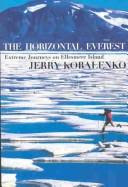
Adam McFarren is one of our newest volunteers here at the library. We hope you are inspired by his review, both to read the book and to write a review yourself!
Jerry Kobalenko's The Horizontal Everest: Extreme Journeys on Ellesmere Island will not appeal to all mountaineers. His pace is
slow, the dangers few and there are no impossible summits to attempt.
But some mountaineers have been attracted to the polar regions (Hillary and Messner to use famous examples) and those who have found enjoyment in a long slog through the hills or are fans of arctic history will likely enjoy Kobalenko's extreme journeys.
The Horizontal Everest starts as expected, with an explanation of how Kobalenko first came to Ellesmere Island, his early mistakes, his equipment, conditions endured (-58F) and his mode of travel (manhauling). He declares "[s]ledding is a lovely occupation, if you like walking." Hauling 200+ pound sleds suddenly sounds like fun after reading Jerry's lyrical descriptions of meditative walking all day through a stark, but beautiful landscape.
Still, his early journeys were all about using "hard travel" to tame a physical restlessness. Endlessly pacing for most of the year, Kobalenko only feels physically at peace immediately after his hard Ellesmere trips. This bolsters his justification for adventure in modern society: "we discover that the happiest state lies near the edge of our capabilities, and extreme journeys take us to that edge."
Early on the expected narrative arc of more adventurous journeys and developing expertise begins to morph into Jerry's later obsession with the people and stories of Ellesmere Island. His trips become less about distance done and more about exploring the land and history of Ellesmere. Meeting an older arctic traveler, he's fascinated by how the man's "Ellesmere was alive with human texture, laced with good
jokes, and well anchored in time with unforgettable characters."
Kobalenko describes his own Ellesmere as having "ghosts, scientific curiosities, and some interesting people, but it was mainly a wild and timeless land." Before the end of the book, we suspect Kobalenko's arctic island has deepened with layers of human texture.
The human stories are not simply retellings of straight laced Victorian-era explorers. Kobalenko's Ellesmere includes morphine addicts, plane crashes, suicides, murders, and adultery - going well beyond the normal polar accidents and starvation. More prominent are the infamous explorers Peary and Cook. Jerry seems amused by their dueling for the North Pole, believing both lied and neither made it, but still tries to understand and like each man. Cook and Peary's personalities are fleshed out as much as their arctic journeys, indeed Kobalenko has a gift for bringing historical figures to life. His final description of the pair reads "I am left with an image of Peary forging doggedly ahead, teeth grit, cursing everything and everyone in his way, and Cook la-de-dahing along, whistling a happy tune, lost in his imagination."
The Everest in the title serves as a too-frequent allusion that seems out of place the more it occurs. Early in the book, gear "used on Everest" and an attempt to answer the "Why?" question about North Pole journeys, invoking Mount Everest make sense. Strained phrases occur later ("Everest Base Camp of North Pole Expeditions" and "Tenzing Norgay of the High Arctic") and distract from the portrait Kobalenko paints of Ellesmere Island. This landscape can stand on its own, without the repeated Everest comparisons.
Kobalenko's book leaves out the geologic history of Ellesmere and crams most of its biology into a one-chapter digression that may have
made sense if the rest of his tale was told chronologically.
Unfortunately, the weaving of Ellesmere's history with his own journeys is done so well throughout the rest of the book that chapter six serves primarily as a break in the flow.
Horizontal Everest succeeds because Jerry doesn't let his own journeys steal from the human history of Ellesmere, but rather uses those travels as an excuse to explore the footsteps a handful of hardy people have made across the high arctic. His own evident fascination for their personalities and his joy at discovering their old cairns makes Ellesmere Island seem anything but a barren land.
Tuesday, June 24, 2008
Book Review: The Horizontal Everest: Extreme Journeys on Ellesmere Island
Tuesday, June 17, 2008
Mountain Gifts Exhibit
Friday, June 6, 2008
New CMC Press Book
Scroll down this article in the Ouray County News to the piece called "On the Shelf." This is a description of a project that CMCF board member John Lacher and CMC Press Publisher Alan Stark have been working on for about two years.
The book described in the article, San Juan Mountaineers' Climber's Guide to Southwestern Colorado, is an unpublished 1932 manuscript by Dwight Lavender and Carleton Long. Only two original copies of this manuscript exist: one at Stanford University and the other in the Colorado Mountain Club Collection at our own library.
Working with Karen Jones, a book conservator with a national reputation, John and Alan have painstakingly reproduced the CMC Collection's original manuscript to create a beautiful hardback book with a slipcase that will be limited to 200 copies. The library will receive copy #1, which will be cataloged and added to the CMC's rare book collection. The book's release date is scheduled for July.
Our plans are to have a special event here at the library sometime in the fall to celebrate the book's release. Check back here for more details on the book and the event.
-Gary Landeck





